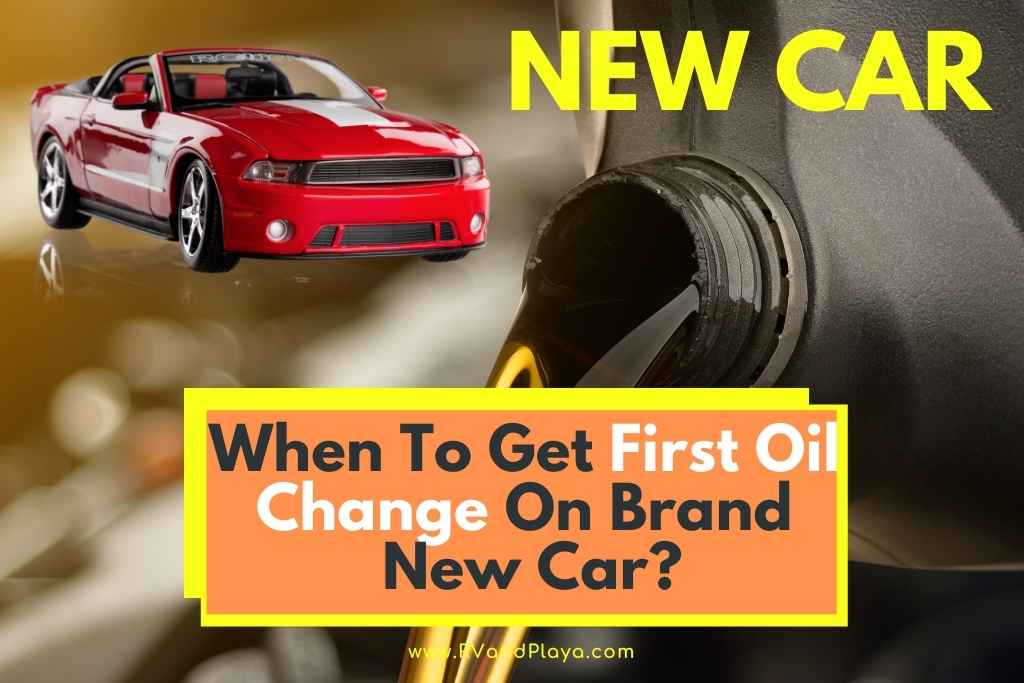When To Get First Oil Change On Brand New Car: A Comprehensive Guide
When To Get First Oil Change On Brand New Car: A Comprehensive Guide cars.truckstrend.com
Buying a brand new car is an exciting milestone. That gleaming paint, the fresh interior scent, and the promise of reliable journeys ahead. But amidst the excitement, a common question often arises that can cause a surprising amount of confusion: "When should I get the first oil change on my brand new car?" This isn’t just a minor detail; the timing of your initial oil change plays a crucial role in the long-term health, performance, and warranty protection of your new vehicle. Understanding the nuances of this critical maintenance step can save you headaches and expenses down the road, ensuring your investment serves you well for years to come.
For decades, the conventional wisdom dictated an immediate oil change after a few hundred or a thousand miles to flush out "break-in" metals. However, modern engine manufacturing has evolved dramatically, leading to more precise tolerances and advanced factory-fill lubricants. This shift has changed the answer to the first oil change question, making it less about tradition and more about informed decision-making based on your specific vehicle and driving habits. This comprehensive guide will demystify the process, providing you with all the information you need to make the right choice for your new ride.
When To Get First Oil Change On Brand New Car: A Comprehensive Guide
The "Break-In" Period and Factory Fill Oil: What You Need to Know
The concept of an engine "break-in" period is rooted in the early days of automotive manufacturing. Historically, new engines had microscopic imperfections on their internal moving parts. The first few hundred or thousand miles were crucial for these parts to "wear in" against each other, seating piston rings, and smoothing out cylinder walls. During this process, tiny metal particles and manufacturing debris would inevitably be generated and circulated within the engine oil. To remove these contaminants, an early oil change was deemed essential.
Modern engines, however, are built with astonishing precision. Computer-controlled machining, laser-honing techniques, and advanced material sciences have reduced the initial wear significantly. Consequently, the amount of metallic debris generated during the initial miles is minimal compared to older engines.
Furthermore, new cars come filled with what’s often referred to as "factory fill" oil. This isn’t just any oil; it’s a carefully selected, high-quality lubricant, often a synthetic or semi-synthetic blend, specifically designed by the manufacturer to facilitate the engine’s initial run-in period. This oil may contain special additives that aid in component seating and provide optimal protection during the engine’s first experiences with varying loads and temperatures. It’s formulated to last for the manufacturer’s recommended initial service interval, which is typically much longer than the traditional "1,000-mile" break-in change.
Consulting Your Owner’s Manual: The Ultimate Authority
When it comes to vehicle maintenance, your owner’s manual is your bible. This often-overlooked document contains specific, detailed instructions tailored to your car’s make, model, and engine. The manufacturer has invested millions in research and development, and their recommendations are based on extensive testing to ensure optimal performance, longevity, and warranty compliance.
Key Information to Look For:
- Mileage Interval: This is the most common recommendation, e.g., "Change oil every 7,500 miles" or "10,000 miles."
- Time Interval: Equally important, as oil degrades over time even if the car isn’t driven much, e.g., "or every 6 months, whichever comes first."
- Oil Type and Viscosity: The manual will specify the exact type of oil (conventional, synthetic blend, full synthetic) and its viscosity grade (e.g., 0W-20, 5W-30), along with any required industry specifications (e.g., API, ILSAC, ACEA ratings, or specific manufacturer approvals). Using the wrong oil can negatively impact engine performance and potentially void your warranty.
- Maintenance Schedule: Beyond the first oil change, the manual will lay out a comprehensive maintenance schedule for all future services.


Ignoring the owner’s manual can lead to premature wear, reduced fuel efficiency, and, crucially, may void your vehicle’s warranty if a major engine issue arises due to neglected maintenance.
Understanding Oil Life Monitoring Systems (OLMS)
Many modern vehicles are equipped with sophisticated Oil Life Monitoring Systems (OLMS) or Maintenance Minder systems. These intelligent systems go beyond simple mileage or time calculations. They use a complex algorithm that takes into account various factors to estimate the remaining life of your engine oil.
How OLMS Works:
OLMS considers variables such as:

- Engine RPMs: Higher RPMs mean more engine revolutions and potentially more stress on the oil.
- Engine Temperature: Extreme temperatures (both hot and cold) can accelerate oil degradation.
- Vehicle Speed: Sustained high speeds versus stop-and-go city driving.
- Trip Lengths: Short trips where the engine doesn’t reach optimal operating temperature can lead to moisture and fuel dilution in the oil.
- Load on Engine: Towing, carrying heavy loads, or driving uphill.
- Number of Cold Starts: Each cold start places stress on the oil.
Based on these factors, the OLMS will display a percentage of oil life remaining, eventually illuminating a "Service Due" or "Change Oil" light when the oil life drops to a critical level (often 0-15%).
Relying on OLMS:
For most drivers under normal conditions, the OLMS is an excellent tool and should be followed. It provides a more accurate assessment of oil degradation than fixed intervals alone. However, it’s wise to combine OLMS readings with a general awareness of your driving habits and the manufacturer’s maximum recommended interval (e.g., even if the OLMS says 20% at 12,000 miles, if the manual says max 10,000 miles, it’s time for a change).
Factors Influencing Your First Oil Change Interval
While the owner’s manual and OLMS are primary guides, several external factors can influence when your first oil change should occur:
- Driving Conditions (Normal vs. Severe): Most manuals define "severe driving conditions" as frequent short trips (less than 5-10 miles), stop-and-go city driving, driving in extreme heat or cold, towing, driving on dusty roads, or prolonged idling. If your driving primarily falls into these categories, your oil will degrade faster, and the manufacturer will likely recommend more frequent oil changes (e.g., every 5,000 miles instead of 10,000). Be honest about your driving habits.
- Climate: Very hot or very cold climates can put additional stress on engine oil, potentially warranting earlier changes.
- Type of Oil (Synthetic vs. Conventional): Most new cars designed for longer oil change intervals (e.g., 7,500+ miles) are factory-filled with synthetic or synthetic blend oils. If, for some reason, your car was filled with conventional oil (less common for modern long intervals), its lifespan would be shorter. When you do your first change, always replace with the manufacturer-specified type.
- Vehicle Usage: A car used for heavy-duty work like frequent towing or hauling will naturally need more frequent oil changes than one used for light commuting.
The "Early Oil Change" Debate: Is It Worth It?
The debate around an early "break-in" oil change (e.g., at 500 or 1,000 miles) for new cars persists, fueled by traditional beliefs.
Arguments for an Early Change:
- Flushing out debris: Some believe that despite modern manufacturing, an early flush helps remove any remaining microscopic metal particles or assembly contaminants that might have accumulated.
- Peace of mind: For some car owners, an early change provides psychological comfort that they’ve done everything possible to ensure their engine’s longevity.
- Establishing a baseline: It can be seen as a way to "reset" the oil life counter and start fresh with a known quantity of oil.
Arguments Against an Early Change (and why it’s generally unnecessary for modern cars):
- Wasting good oil: The factory-fill oil is specifically designed for the break-in period and contains beneficial additives. Changing it too early removes these.
- Unnecessary cost: It’s an added expense that, for most modern vehicles, provides no tangible benefit.
- Modern engine precision: As discussed, manufacturing tolerances are so tight now that the amount of harmful debris generated during break-in is negligible. The oil filter is designed to capture these minute particles.
- Manufacturer’s recommendation: If the manufacturer doesn’t recommend it, it’s likely not necessary. Deviating from their schedule without good reason can sometimes even be questioned during warranty claims, though an earlier change is rarely an issue.
Conclusion on Early Change: For the vast majority of brand new cars, an early oil change before the manufacturer’s first recommended interval (or before the OLMS indicates) is not necessary. It won’t harm your car, but it’s an expense without a significant engineering benefit for modern vehicles. Always prioritize the owner’s manual.
Choosing the Right Oil for Your First Change (and Beyond)
Once it’s time for that first oil change, selecting the correct oil is paramount. Do not simply ask for "a standard oil change."
- Adhere to Manufacturer Specifications: Your owner’s manual will specify:
- Viscosity: (e.g., 0W-20, 5W-30). This is the oil’s thickness at different temperatures.
- Type: (Conventional, Synthetic Blend, Full Synthetic). Most new cars require synthetic or synthetic blend.
- API/ILSAC/ACEA Ratings and Manufacturer Approvals: These are crucial quality and performance standards (e.g., API SP, ILSAC GF-6, DEXOS, VW 504 00). Using oil that doesn’t meet these specific ratings can lead to engine wear, reduced fuel economy, and potential warranty issues.
- Quality Oil Filter: Always use a high-quality oil filter that meets or exceeds OEM (Original Equipment Manufacturer) specifications. The filter works hand-in-hand with the oil to keep your engine clean. Many manufacturers recommend their own brand filters.
The Role of Dealerships and Independent Mechanics
For your first oil change, many new car owners opt to go back to the dealership where they purchased the car.
Dealership Advantages:
- OEM Parts: They typically use genuine OEM parts and the exact oil specified by the manufacturer.
- Trained Technicians: Their technicians are often factory-trained and specialize in your specific vehicle brand.
- Warranty Protection: Having service done at the dealership creates a clear service record, which can be beneficial if a warranty claim arises.
- Software Updates/Recalls: They may perform any outstanding software updates or address recalls during your service visit.
Independent Mechanic Advantages:
- Cost: Often more affordable than dealerships.
- Personalized Service: You might develop a more personal relationship with an independent shop.
- Flexibility: Potentially more flexible scheduling.
Regardless of where you go, ensure they use the correct oil and filter as specified in your owner’s manual. Always keep detailed records of your oil changes, including mileage, date, type of oil used, and the service provider.
Practical Advice and Actionable Insights
- Read Your Owner’s Manual Immediately: Before you even think about the first oil change, understand what your car’s manufacturer recommends. This is the single most important piece of advice.
- Understand Your Driving Habits: Be realistic about whether your driving falls under "normal" or "severe" conditions, as this will influence your actual service interval.
- Don’t Fear the OLMS: If your car has an Oil Life Monitoring System, trust it, but also be aware of the maximum mileage/time interval specified in your manual.
- Keep Meticulous Records: Document every oil change (date, mileage, oil type, where it was done). This is vital for warranty purposes and resale value.
- Don’t Fall for Unnecessary Upsells: Be wary of service centers pushing for earlier oil changes or additional services not recommended by your owner’s manual. Ask questions and refer back to your manual.
- Budget for Quality: Investing in the correct, high-quality oil and filter is a small price to pay for the longevity and health of your engine.
Estimated First Oil Change Costs
Please note that these are estimated prices and can vary significantly based on your vehicle’s make and model, the specific oil required, your geographic location, and whether you choose a dealership or an independent mechanic. Always get a specific quote for your vehicle.
| Service Type | Estimated Mileage/Time | Estimated Cost Range (Low) | Estimated Cost Range (High) | Notes |
|---|---|---|---|---|
| Manufacturer Recommended (Conventional) | Typically 3,000 – 5,000 miles or 3-6 months | $35 | $65 | Less common for new cars, usually for older models or specific base engines. Uses conventional oil. |
| Manufacturer Recommended (Synthetic Blend) | Typically 5,000 – 7,500 miles or 6-9 months | $50 | $85 | Common for many new vehicles. Offers better protection than conventional. |
| Manufacturer Recommended (Full Synthetic) | Typically 7,500 – 12,000 miles or 9-12 months (or per OLMS) | $70 | $120+ | Most common for modern engines with long service intervals. Required for many performance and luxury vehicles. Costs vary significantly based on specific synthetic oil required. |
| Early "Break-in" Change (Optional) | 500 – 1,500 miles (if chosen for peace of mind) | $50 | $120+ | Cost depends on whether the original factory fill was conventional, blend, or synthetic. Generally not necessary for modern cars. Price range similar to recommended change based on oil type. |
Frequently Asked Questions (FAQ)
Q1: Is an early oil change necessary for new cars (e.g., at 1,000 miles)?
A1: For most modern cars, no. Manufacturers design their engines with precise tolerances and use high-quality factory-fill oil that is intended to last for the initial recommended service interval, typically 5,000-10,000 miles or more. Consult your owner’s manual.
Q2: What happens if I don’t change the oil on time?
A2: Neglecting oil changes can lead to severe engine damage, including excessive wear on moving parts, sludge buildup, reduced fuel efficiency, and eventually engine failure. It can also void your vehicle’s warranty.
Q3: Does an early oil change void the warranty?
A3: No, changing the oil earlier than recommended will not void your warranty. However, changing it later than recommended or using the wrong type of oil can.
Q4: Can I use synthetic oil for the first change if my car came with conventional?
A4: Yes, if your manual allows for it, you can switch to synthetic oil. In fact, many manufacturers now specify synthetic oil due to its superior protective properties and longer lifespan. Always ensure the synthetic oil meets all the specifications (viscosity, API ratings, manufacturer approvals) listed in your owner’s manual.
Q5: How do I know what type of oil my car needs?
A5: The type, viscosity, and specific certifications for your engine oil are clearly stated in your vehicle’s owner’s manual, usually in the "Maintenance" or "Specifications" section. There might also be a sticker under the hood.
Q6: Should I go to the dealership for my first oil change?
A6: While not strictly mandatory, many new car owners prefer to go to the dealership for their first service. Dealerships use OEM parts, have factory-trained technicians, and create a clear service record, which can be beneficial for warranty purposes. However, a reputable independent mechanic who adheres to manufacturer specifications is also a viable option.
Conclusion
The question of "When to get the first oil change on a brand new car" is less complex than it often seems. In the vast majority of cases, the most reliable and beneficial course of action is to follow the recommendations outlined in your vehicle’s owner’s manual. Modern engines, coupled with advanced factory-fill lubricants and sophisticated oil life monitoring systems, mean that the traditional early "break-in" oil change is largely a relic of the past.
By understanding your manual, paying attention to your driving conditions, and trusting your car’s intelligent monitoring systems, you can ensure your new vehicle receives the proper care it needs. This proactive approach to maintenance will not only safeguard your engine’s longevity and performance but also protect your valuable investment and ensure years of reliable, worry-free driving.





